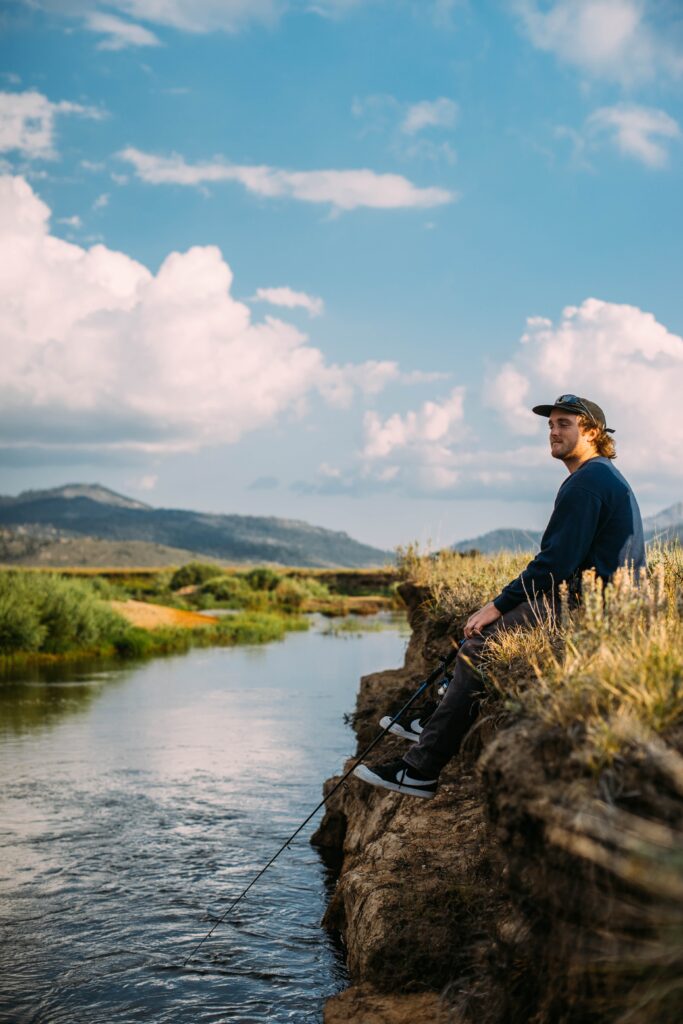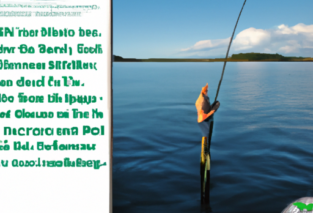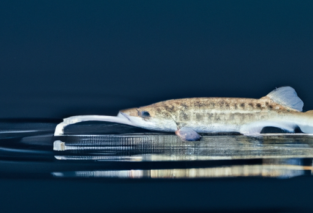If you’re an avid angler wondering whether or not trout fishing is possible during the summertime, we have the answers for you. Our product, “Can You Go Trout Fishing in Summer: Essential Tips and Techniques,” is a comprehensive guide that offers valuable insights and expert advice on how to make the most out of your summer fishing adventures. Packed with essential tips and techniques, this guide will help you navigate the challenges that trout fishing in summer presents, ensuring a successful and enjoyable fishing experience. Whether you’re a seasoned angler or a beginner looking to expand your fishing repertoire, “Can You Go Trout Fishing in Summer: Essential Tips and Techniques” is a must-have resource for your fishing arsenal.

Benefits of Summer Trout Fishing
1. Warmer water temperatures
Summer is a fantastic time for trout fishing because the water temperatures are warmer. Unlike in colder seasons, when trout tend to slow down and become less active, the warmer water temperatures of summer make them more lively and eager to bite. This means that you have a higher chance of hooking into some big, beautiful trout during this time of year.
2. Active fish behavior
Trout are known for their aggressive behavior during the summer months. They become more active and move around a lot, making it easier for anglers to locate and target them. This increased activity level also means that trout are more likely to go after your bait or fly, resulting in more successful fishing trips.
3. Abundance of insect hatches
Summer is a time of plentiful insect hatches, which is a major food source for trout. As the temperature rises, insects hatch and make their way to the water, providing a feast for hungry trout. This abundance of insects increases the chances of trout feeding on the surface, making it a prime time for fly fishing enthusiasts to practice their skills. So, if you enjoy the thrill of watching trout rise to the surface to take your fly, summer trout fishing is definitely for you.
Choosing the Right Location
1. Research local fishing spots
Before heading out for a summer trout fishing adventure, it’s important to research and familiarize yourself with the local fishing spots in your area. Look for lakes, rivers, or streams that are known for their summer trout populations. Online fishing websites, local fishing forums, and regional fishing guides can be great sources of information to help you identify the best fishing spots near you.
2. Consider river and stream options
Rivers and streams are often excellent options for summer trout fishing. These moving water bodies provide crucial habitat for trout, as they offer oxygen-rich water and a constant supply of food. Look for areas with gentle current breaks, such as deep pools, riffles, and eddies, where trout are likely to be feeding and seeking shelter from the warmer water temperatures.
3. Select higher altitude areas
When it comes to summer trout fishing, higher altitude areas can offer a cooler and more comfortable fishing experience. Trout tend to seek out cooler waters when temperatures rise, and streams in higher elevation locations often maintain lower water temperatures due to cooler mountain air and melting snow. By targeting these higher altitude areas, you’ll increase your chances of finding active trout and avoid the potentially uncomfortable heat of lower elevation fishing spots.

Selecting the Appropriate Tackle and Gear
1. Opt for light to medium-weight fishing rods
When choosing a fishing rod for summer trout fishing, it’s best to opt for a light to medium-weight rod. A lighter rod allows for better sensitivity, which is crucial for detecting the subtle bites of trout. Additionally, a lighter rod will provide a more enjoyable fishing experience, as it won’t feel cumbersome during those long days on the water.
2. Choose the right fishing line and leader
For summer trout fishing, a lighter fishing line with a test strength between 4-8 pounds is usually sufficient. A light line allows for more delicate presentations and makes it easier to cast smaller lures or flies. When it comes to leaders, a fluorocarbon leader can be a great choice, as it offers excellent invisibility and abrasion resistance, increasing your chances of fooling wary trout.
3. Pick the appropriate hooks, flies, and bait
The choice of hooks, flies, and bait can greatly impact your success in summer trout fishing. For fly fishing enthusiasts, stocking your fly box with a variety of dry flies, nymphs, and small streamers is essential. Dry flies imitate insects floating on the water’s surface and can be incredibly effective during insect hatches. Nymphs, on the other hand, mimic insects in their larval stage and are great for fishing below the water’s surface. If you prefer bait fishing, opt for natural baits like worms, corn, or small insects to entice hungry trout.
Understanding Trout Behavior in Summer
1. Knowledge of preferred habitat
Understanding the preferred habitat of trout during summer can significantly increase your chances of finding and catching them. Trout typically seek out areas with cooler water temperatures, such as deep pools, undercut banks, log jams, and areas with ample shade. These areas provide trout with protection from the sun and access to food sources, making them prime fishing locations.
2. Learning preferred feeding patterns
Trout have specific feeding patterns that can be essential knowledge for successful summer trout fishing. Early mornings and late evenings are often the most productive times, as trout tend to be more active during these cooler parts of the day. Pay attention to the different insect hatches and try to match your fly or bait to what the trout are actively feeding on. By presenting your offerings in a manner that mimics natural prey, you’ll greatly increase your chances of enticing a trout to strike.
3. Identifying prime fishing time
Knowing the prime fishing times during summer can make a big difference in your success rate. Trout are more active in cooler water temperatures, so fishing early in the morning or late in the evening can be highly productive. These are the times when trout are most likely to be actively feeding and searching for food. By planning your fishing trips around these optimal times, you’ll maximize your chances of hooking into some impressive trout.

Mastering Fly Fishing Techniques
1. Utilizing dry fly fishing
Dry fly fishing is an exciting and visual technique that can be highly successful during the summer months. When trout are actively feeding on insects hatching on the water’s surface, presenting a dry fly that imitates the natural insect can result in explosive strikes. Pay close attention to the water for rising trout and cast your dry fly upstream, allowing it to float naturally downstream. Be patient, observe the trout’s behavior, and time your hookset properly for a thrilling experience.
2. Nymph fishing techniques
Nymph fishing is a highly effective method for targeting trout, especially when they are not actively rising to dry flies. Nymphs imitate the underwater stage of insects, which constitute a significant portion of a trout’s diet. To nymph fish, use a strike indicator to detect subtle takes and adjust the depth of your nymph accordingly. Cast slightly upstream and allow your nymph to drift naturally downstream, keeping an eye on your indicator for any sudden movement. Be ready for a quick hookset when you see the indicator twitch or submerge.
3. Streamer fishing methods
Streamer fishing involves using larger, more flashy flies that imitate baitfish or other small aquatic creatures. This technique is perfect for targeting larger, predatory trout. Cast your streamer across the current and let it swing downstream, mimicking the motion of a wounded baitfish. Use slow, deliberate strips to impart movement to the streamer, enticing aggressive trout to strike. Streamer fishing can be particularly effective during low light conditions or when water visibility is reduced, as the bigger profile and movement of the streamer can attract trout from a distance.
Tips for Successful Summer Trout Fishing
1. Use light and stealthy approach
Trout are notorious for being easily spooked, especially in clear summer waters. To maximize your chances of success, approach the fishing spot quietly and avoid making unnecessary disturbances. Dress in neutral, earth-toned clothing that blends with the surroundings, and try to keep your movements slow and deliberate. By adopting a light and stealthy approach, you’ll minimize the chances of alerting trout to your presence and increase your chances of getting them to bite.
2. Pay attention to water temperature
During the summer, water temperatures can rise significantly, and trout become more sensitive to these fluctuations. Pay attention to the water temperature and adapt your fishing tactics accordingly. If the water temperature is too warm, trout may become lethargic and seek out cooler, oxygen-rich areas. In this case, focus your efforts on fishing in deeper pools or shaded sections of the waterbody where trout are likely to congregate.
3. Experiment with different fishing techniques
Trout can be selective feeders, and what works one day may not work the next. To increase your chances of success, be willing to experiment with different fishing techniques, flies, and bait. If dry flies aren’t producing any bites, try switching to nymphs or streamers. Change up the retrieve speed or depth of your fly or adjust the size or color of your bait. By being adaptable and willing to try new approaches, you’ll be better equipped to entice trout into biting even when they may be finicky.

Proper Catch and Release Techniques
1. Handle trout with care
When practicing catch and release, it’s important to handle trout with care to ensure their survival after being released. Wet your hands to avoid removing the protective slime layer on the fish’s skin, which can make them more prone to infections. Hold the trout gently and support its body, avoiding excessive squeezing or bending. Minimize the time the fish spends out of the water and release it back into the water carefully, allowing it to swim away on its own.
2. Use barbless hooks
Using barbless hooks can greatly reduce the harm done to trout during catch and release. Barbless hooks are easier to remove, causing less stress and injury to the fish. They also make it quicker to release the fish, minimizing the time it spends out of the water. If barbless hooks are not readily available, consider flattening the barbs on your hooks with pliers to achieve a similar effect.
3. Minimize stress and harm to the fish
To minimize stress and harm to the trout, avoid playing it excessively during the fight. Use the appropriate tackle and gear to bring the fish in as quickly as possible. Avoid dragging the trout onto dry ground or rocks, as this can cause physical damage to the fish. If the trout is deeply hooked or injured, consider keeping it for consumption rather than releasing it, as the chances of its survival may be significantly reduced.
Dealing with Summer Weather Challenges
1. Early morning and late evening fishing
During the summer, the midday sun can make fishing uncomfortable and less productive. To beat the heat and increase your chances of success, plan your fishing trips for the early morning or late evening when temperatures are cooler. Not only will you avoid the scorching sun, but you’ll also fish during prime feeding times when trout are more active and likely to bite.
2. Adjust tactics for warm water
As water temperatures rise in summer, trout become more sensitive to heat and may seek out cooler areas or become less active. Adjust your tactics accordingly, focusing on fishing in deeper pools or shaded sections of the waterbody where trout are more likely to gather. Use slower presentations and fish deeper to target those less-active trout that may be seeking a more comfortable environment.
3. Stay hydrated and protect yourself from the sun
When fishing in the summer heat, it’s essential to stay hydrated and protect yourself from the sun’s harmful rays. Bring plenty of water and stay hydrated throughout the day, particularly if you’re spending long hours on the water. Apply sunscreen generously to protect your skin from sunburn, and wear a wide-brimmed hat, polarized sunglasses, and lightweight, breathable clothing to shield yourself from the sun’s intensity. By taking care of your own well-being, you’ll be able to fully enjoy your summer trout fishing adventures.

Trout Fishing Regulations and Ethics
1. Familiarize yourself with local fishing regulations
Before you embark on a summer trout fishing trip, make sure to familiarize yourself with the local fishing regulations. Fishing regulations can vary from one area to another, and it’s important to know the rules governing catch limits, size restrictions, and fishing seasons. Adhering to these regulations helps ensure the sustainability of trout populations and preserves the opportunities for future generations of anglers to enjoy the sport.
2. Practice ethical fishing practices
Ethical fishing practices are essential for preserving the health of trout populations and the overall ecosystem. Avoid littering and dispose of any garbage properly to prevent pollution. Never leave fishing lines or hooks behind, as they can entangle and harm wildlife. Treat the fish with respect by handling them carefully, practicing catch and release whenever possible, and minimizing any harm or stress inflicted upon them.
3. Respect the environment and other anglers
When trout fishing in the summer, it’s important to respect the environment and other anglers. Leave the fishing spot as you found it, taking care not to disturb natural habitats or damage vegetation. Respect other anglers’ space and privacy, giving them plenty of room to fish without encroaching on their fishing spots. By showing respect for the environment and fellow anglers, you contribute to a positive fishing experience for everyone involved.
Benefits of Hiring a Fishing Guide
1. Local expertise and knowledge
Hiring a fishing guide can provide you with invaluable local expertise and knowledge. Guides are often seasoned anglers who know the best fishing spots in the area, as well as the techniques and tactics that yield the most success. They can guide you to productive waters, share insights on fish behavior, and provide tips to improve your fishing skills. Their expertise can greatly enhance your chances of having a successful and fulfilling summer trout fishing experience.
2. Insights on fishing techniques
Fishing guides have extensive knowledge of various fishing techniques and can teach you how to master them. They can provide hands-on instruction on casting techniques, fly presentation, and effective retrieval methods. By learning from a guide, you’ll gain a deeper understanding of the intricacies involved in successful trout fishing and be able to apply these techniques on future fishing adventures.
3. Increased chances of success
One of the primary benefits of hiring a fishing guide is the increased chances of success. Guides have intimate knowledge of the local fishing conditions, including where the trout are likely to be, what they’re feeding on, and the best times to fish. Their experience and insights can help you avoid unproductive waters and focus on areas where trout are actively biting. With a guide by your side, you’ll have a higher probability of hooking into some trophy-worthy trout and creating lasting memories.
In conclusion, summer trout fishing offers a wealth of benefits, including warmer water temperatures, active fish behavior, and an abundance of insect hatches. By choosing the right location, selecting appropriate tackle and gear, understanding trout behavior, and mastering fly fishing techniques, you can greatly increase your chances of success. Remember to always practice proper catch and release techniques, respect fishing regulations and ethics, and take precautions to deal with summer weather challenges. Whether you choose to embark on your summer trout fishing adventure alone or hire a fishing guide, the thrill of hooking into a beautiful trout and the serenity of being out in nature make it an experience well worth pursuing. So grab your fishing gear, visit your local fishing spots, and embark on a summer trout fishing journey that will leave you with memories to cherish for a lifetime.





